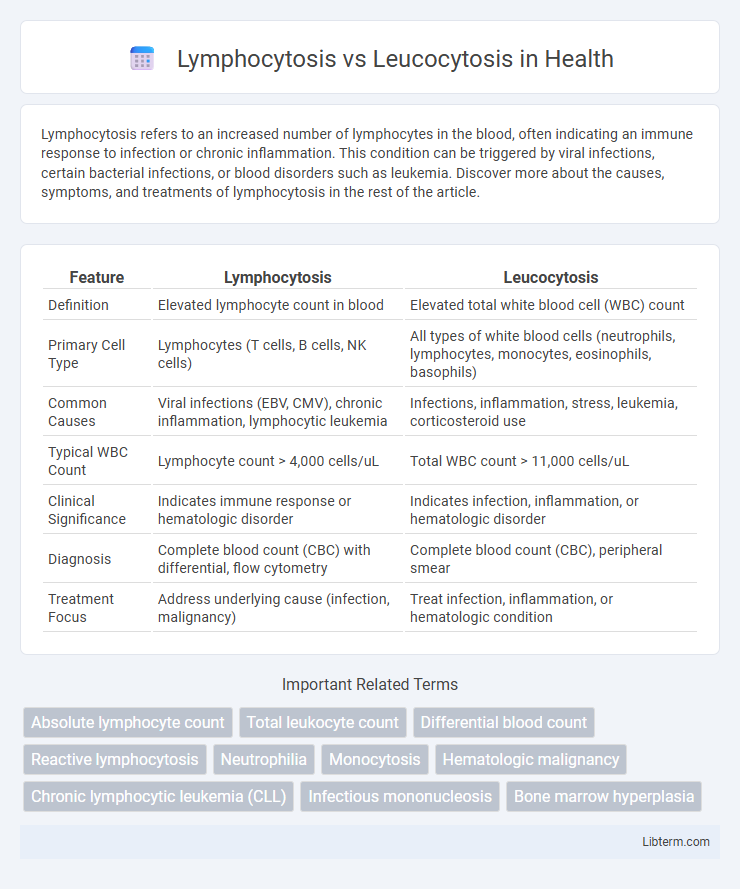Lymphocytosis refers to an increased number of lymphocytes in the blood, often indicating an immune response to infection or chronic inflammation. This condition can be triggered by viral infections, certain bacterial infections, or blood disorders such as leukemia. Discover more about the causes, symptoms, and treatments of lymphocytosis in the rest of the article.
Table of Comparison
| Feature | Lymphocytosis | Leucocytosis |
|---|---|---|
| Definition | Elevated lymphocyte count in blood | Elevated total white blood cell (WBC) count |
| Primary Cell Type | Lymphocytes (T cells, B cells, NK cells) | All types of white blood cells (neutrophils, lymphocytes, monocytes, eosinophils, basophils) |
| Common Causes | Viral infections (EBV, CMV), chronic inflammation, lymphocytic leukemia | Infections, inflammation, stress, leukemia, corticosteroid use |
| Typical WBC Count | Lymphocyte count > 4,000 cells/uL | Total WBC count > 11,000 cells/uL |
| Clinical Significance | Indicates immune response or hematologic disorder | Indicates infection, inflammation, or hematologic disorder |
| Diagnosis | Complete blood count (CBC) with differential, flow cytometry | Complete blood count (CBC), peripheral smear |
| Treatment Focus | Address underlying cause (infection, malignancy) | Treat infection, inflammation, or hematologic condition |
Introduction to Lymphocytosis and Leucocytosis
Lymphocytosis refers to an abnormal increase in lymphocyte count, typically exceeding 4,000 lymphocytes per microliter of blood, often indicating viral infections, chronic inflammation, or certain hematologic disorders. Leucocytosis denotes an elevated total white blood cell count above the normal range, usually over 11,000 cells per microliter, associated with infections, inflammation, stress, or malignancies. Understanding the differences in cell type predominance and underlying causes is crucial for accurate diagnosis and targeted treatment strategies in hematology.
Definition of Lymphocytosis
Lymphocytosis is defined as an abnormal increase in the number of lymphocytes in the blood, typically exceeding 4,000 cells per microliter in adults, and often signals infections, chronic inflammation, or certain hematologic diseases. Unlike leucocytosis, which represents an increase in the total white blood cell count including neutrophils, eosinophils, basophils, monocytes, and lymphocytes, lymphocytosis specifically involves a disproportionate rise in lymphocytes. This condition is commonly associated with viral infections, such as infectious mononucleosis, and hematological malignancies like chronic lymphocytic leukemia.
Definition of Leucocytosis
Leucocytosis is a condition characterized by an elevated white blood cell (WBC) count above the normal range, typically exceeding 11,000 cells per microliter of blood, indicating an immune response to infection, inflammation, or other physiological stress. Lymphocytosis, a subtype of leucocytosis, specifically involves an increased number of lymphocytes, a subset of WBCs, often linked to viral infections or certain hematologic disorders. Understanding leucocytosis involves recognizing the broad increase in all white blood cells, while lymphocytosis pertains to the disproportionate rise of lymphocytes within the leucocyte population.
Causes of Lymphocytosis
Lymphocytosis primarily results from viral infections such as infectious mononucleosis, cytomegalovirus, and viral hepatitis, as well as chronic inflammatory conditions like tuberculosis and autoimmune diseases. It can also be caused by lymphoproliferative disorders including chronic lymphocytic leukemia (CLL) and acute lymphoblastic leukemia (ALL). In contrast, leucocytosis generally reflects an elevated total white blood cell count due to bacterial infections, inflammation, trauma, or stress responses.
Causes of Leucocytosis
Leucocytosis primarily results from infections, inflammation, tissue damage, stress, or bone marrow disorders, causing an elevated white blood cell count. It can also be triggered by leukemia, certain medications like corticosteroids, and immune system disorders. Distinct from lymphocytosis, which specifically involves an increase in lymphocytes, leucocytosis encompasses a rise in all types of white blood cells, including neutrophils, eosinophils, basophils, monocytes, and lymphocytes.
Key Differences Between Lymphocytosis and Leucocytosis
Lymphocytosis is characterized by an elevated count of lymphocytes, a specific type of white blood cell involved in immune responses, often linked to viral infections or certain chronic inflammatory conditions. Leucocytosis refers to an overall increase in the total white blood cell count, including neutrophils, eosinophils, basophils, monocytes, and lymphocytes, typically indicating bacterial infections, inflammation, stress, or bone marrow disorders. While lymphocytosis highlights a selective lymphocyte increase, leucocytosis encompasses a broader white blood cell elevation across various subtypes.
Diagnostic Approach for Lymphocytosis vs Leucocytosis
Lymphocytosis is diagnosed primarily through a complete blood count (CBC) with differential, highlighting an elevated lymphocyte count often exceeding 4,000 cells/uL in adults, whereas leucocytosis indicates a general increase in total white blood cells above 11,000 cells/uL. Flow cytometry and peripheral blood smear analysis are essential in distinguishing lymphocytosis from other causes of leucocytosis by identifying lymphocyte subsets and morphological abnormalities. Further diagnostic steps include viral serology, bone marrow biopsy, and immunophenotyping to determine the underlying etiology, whether reactive, infectious, or malignant.
Clinical Manifestations and Symptoms
Lymphocytosis primarily presents with symptoms such as persistent fatigue, night sweats, and unexplained weight loss, often indicating viral infections or hematologic malignancies like chronic lymphocytic leukemia. Leucocytosis manifests with clinical signs including fever, inflammation, and localized pain due to infections, trauma, or inflammatory diseases, reflecting an elevated total white blood cell count. Differentiating these conditions relies on the specific white cell subtype increase, guiding targeted diagnostic and therapeutic approaches.
Treatment and Management Strategies
Treatment and management of lymphocytosis primarily target the underlying cause, often involving antiviral medications for viral infections or immunosuppressive therapy in cases of chronic lymphocytic leukemia. Leucocytosis management depends on the etiology, such as antibiotics for bacterial infections and corticosteroids for inflammatory disorders. Regular monitoring of white blood cell counts and addressing root causes are essential for both conditions to prevent complications and ensure effective recovery.
Conclusion: Importance of Differentiating Lymphocytosis and Leucocytosis
Differentiating lymphocytosis from leucocytosis is crucial for accurate diagnosis and targeted treatment, as lymphocytosis specifically indicates an increased lymphocyte count often linked to viral infections or certain hematologic malignancies, whereas leucocytosis refers to a broader elevation in white blood cells, commonly due to bacterial infections or inflammation. Misinterpretation can lead to inappropriate management strategies, emphasizing the need for detailed blood count analysis and clinical correlation. Precise identification informs prognosis and guides therapeutic decisions in hematology and infectious disease contexts.
Lymphocytosis Infographic

 libterm.com
libterm.com